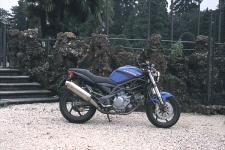2001 Cagiva Raptor 650 - Motorcycle.com
Eastern Hemishpere, January 15, 2001
If history is to be believed, those polite and refined Italians -- fine blokes that churn out design masterpieces by the truckload -- were once a rowdy crowd.
For ages, bloody battles raged between rival Kingdoms. Unfortunately, it seems that serious conflict between Varese and Bologna is once again looming on the horizon. The matter of dispute? The lucrative naked bike market.
Thou shall not take this lightly. The granddad of them all, the Ducati Monstro, brings in close to 70-percent of Ducati's income these days. But Cagiva's boss, Mr. Castiglioni, is not about to let the Bolognese people dig this gold mine all alone. After unveiling the 1000 Raptor at the '00 Milano show, a smaller but no less appealing 650 brother appeared at this year's Munich Show. When you consider the fact that in Italy, the small 600cc Monstro is number four in the sales hit parade with 4,500 pieces sold (twice the sales of the 900), it's no wonder why Cagiva came out with a smaller model of their own.
Just a few weeks ago I had the chance to visit the Cagiva/MV factory in Varese. After drooling over row after row of assembled MV 750 engines that regrettably would not fit under my coat, I was handed the keys to the new 650 Raptor.
Upon first look, I was hard-pressed to detect any differences from the 1000cc model parked next to it. The 650 keeps the exact design of its larger sibling with hard and somewhat ornate lines. The only external clues to the actual capacity (engine externals aside) are the smaller silencers and 20 millimeter narrower back wheel. Other than that, the 650 keeps the same top-level equipment found on the 1000 model. That means 43 mm inverted Marzochi forks, dual 298 mm front disks, Brembo calipers all around and a Sachs schock.
Cagiva's parking lot is a much nicer place than a crowded exhibition hall for close examination of the endless design details present in the Raptor. Look closely at the pictures and you'll be amazed at the amount of special parts that have been specifically designed to fit with the Raptor's lines: The footrests and hangers, the small covers under the instrument pod and the instrument pod itself all carry those angular and oval design cues. Wherever the eye rests it'll find Galluzzi's touch. No off-the-shelf items. Oh no. It's no easy feat for a small company like Cagiva to resist the temptation of using universal parts in order to be faithful to the designer's vision. This is no committee-designed Japanese bike. Each bike is the result of a few people's dream.
After some ignition key twirling and starter button pressing, the SV650 engine responds with a rather polite and restrained exhaust note. First gear engages in typicallly smooth Suzuki fashion and away we pull, courtesy of that small but torquey V-twin. The first few miles find me splitting lanes while looking for the shortest way to the nearest restaurant. Those MV Agusta engines somehow whetted my appetite.
After a good dish of pasta marinara, I'm off to look for some twisties. Just as it should be, the short and nimble Raptor slashes through city traffic admirably. The straight bars, sharp brakes, upright riding stance and immediate though not intimidating power make the 650 a wonderful city tool. At slow speeds over potholes and train crossings the suspension feels Italian -- taut but not excessively so. The lack of nose diving under braking is a blessing compared to a standard Suzuki SV650.When you consider that the 650 has almost the same top-end power of Ducati's 900 cc air-cooled mill (about 70 rear wheel hp) things start getting down to which perspective you look at things from. The 650 Raptor might not pull as strong from down low as the Ducati, but the Raptor makes up for the deficit with its higher revving engine and shorter gearing. Then there is the typical Japanese lack of mechanical noise. Dyed-in-the-wool Italian bike buffs will certainly complain that the Raptor lacks that special mechanical charisma ever so present in any Ducati. Let them talk while you enjoy Japanese reliabilty wraped in sexy Italian clothes.
OK then, is it a Monstro beater? At a price that undercuts even the much weaker Monstro 750 it should be, although Cagiva has yet to accumulate even a fraction of Ducati's street, race and sales cred. But then, don't be surprised to hear about bad riots between Italian mobs armed with Raptors and Monstros at the halfway point between Varese and Bologna. These guys have a tradition to maintain.
Specifications
Engine: Liquid-cooled 90° 4-stroke V-TwinValves: 4 per cylinder, DOHCCapacity: 645ccBore x Stroke 81 x 62.6 mmIntake system: Mikuni BDSR 39mm CarbsClutch: Wet multiplateTransmission: 6speed, chain final driveFt Suspension: 43 mm inverted MarzocchiRr suspension: Sachs damper, preload adjustableFront brakes: 2 x four piston Brembo calipers,2 x 298 mm discsRear brakes: twin piston Brembo caliper,220 mm discFront tire: 120/70 x 17Rear tire: 160/60 x 17Rake/Trail: 25.2°/110 mmWheelbase: 1440 mmSeat Height: 775 mmFuel capacity: 19 litersDry Weight: 180 kgInstruments: Digital speedometer and scrollabledigital readout for coolant temp, odometer, trip mileage (x 2). Tachometer, warning lights for neutral,high beam, turn signals and low fuel
More by Yossef Schvetz

































Comments
Join the conversation